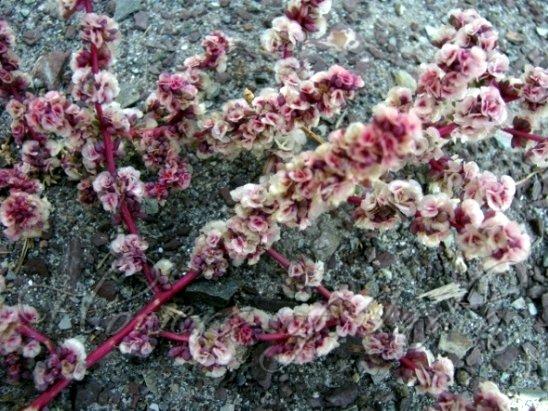|
| Salt-Lover |
|

|

| File size | 83582 |
| Original date | 9/14/11 9:44 AM |
| Resolution | 548 x 411 |
| Flash | Flash did not fire, auto |
| Focal length | 6.0mm |
| Exposure time | 1/640s |
| Aperture | 2.7 |
| Focus Distance | |
| Metering Mode | Center weighted average |
| Camera make | Canon |
| Camera model | Canon PowerShot S5 IS |
| Sensor type | OneChipColorArea |
|
|
|
|
Photo: |
Botanical name: Halogeton glomeratus Family: Chenopodiaceae (Cat-tail family)
Synonyms: Halogeton tibeticus, Halogeton kashmirianus, Salsola glomerata
Synonyms: Halogeton tibeticus, Halogeton kashmirianus, Salsola glomerata
Salt-lover is a hardy annual herb, thriving in
soils far too saline to support many other plants. The plant produces a
usually erect stem with several curving branches up to about 25 cm
tall. It has a taproot reaching up to half a meter deep in the soil and
many lateral roots. The branches are lined with narrow, fleshy,
blue-green leaves each up to about 2 cm long tipped with stiff
bristles. The inflorescences are located all along the stem branches
next to the leaves. Each inflorescence is a small cluster of tiny
bisexual and female-only flowers accompanied by waxy bracts. The
winged, membranous flowers surround the developing fruit, which is all
that remains on the plant when it is ripe, the leaves and flower parts
having fallen away. The fruit is a pale cylindrical utricle. The plant
produces large amounts of seeds, which are dispersed by many vehicles,
including human activity, animals (including ants), water flow, wind,
and by being carried on the dry plant when it breaks off at ground
level and rolls away as a tumbleweed. The seeds have the ability to
germinate within one hour after being exposed to water. Salt-Lover is
native to C. Asia and N. Pakistan. It has probably become naturalized
in parts of the Himalayas. Flowering: July-September.
| Identification credit: Miroslav Dvorsky | Photographed in Puga-Sumdo, Ladakh. |
• Is this flower misidentified? If yes,